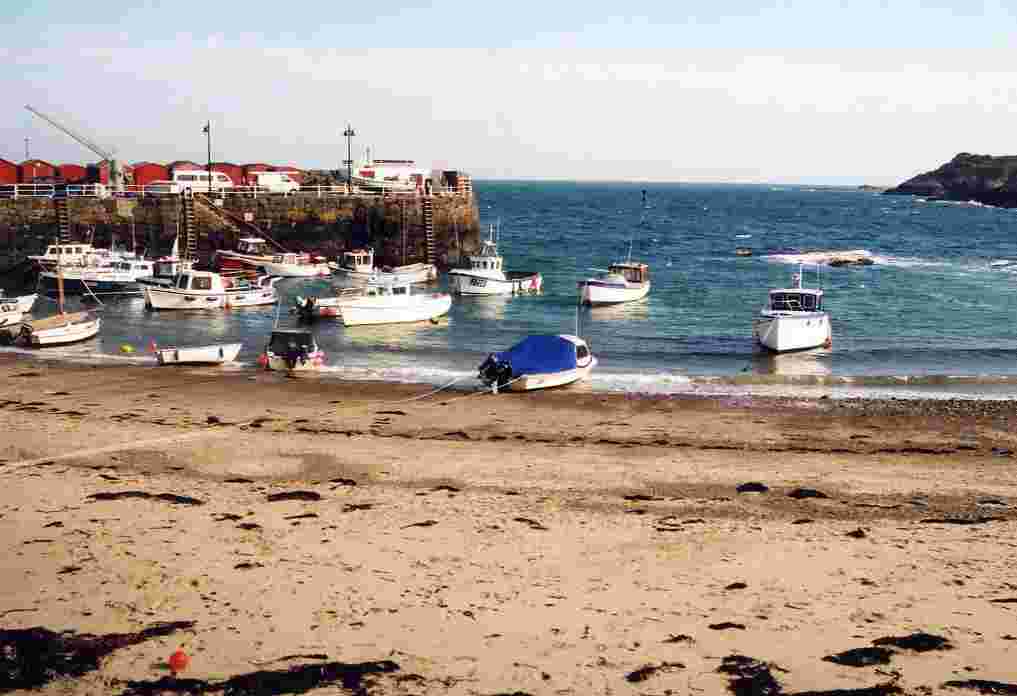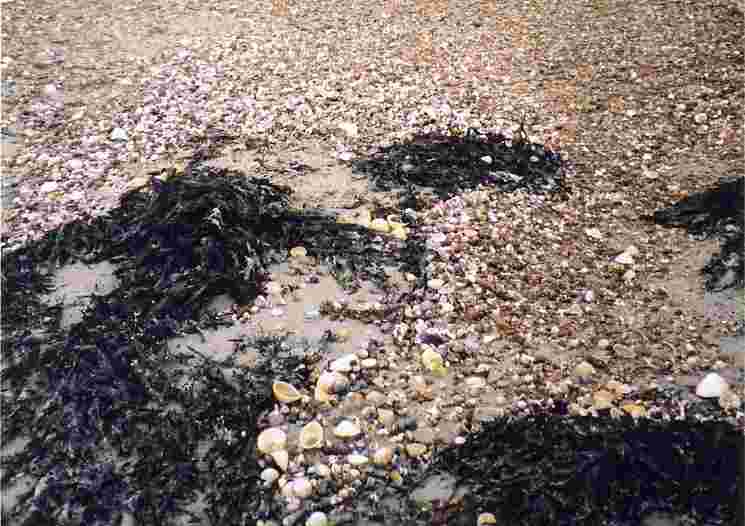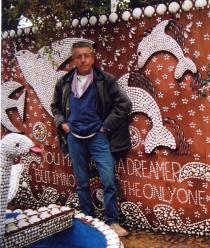A Selina Wilkins report
I had the opportunity to go to Jersey Island on business, and decided to extend my visit to do some shelling. Luckily for me, a club member, Janet Sawyer, gave me some excellent tips so I was able to visit the most worthwhile beaches, and avoid disappointments. Time however was limited, so I only had two full days, with family to keep happy too. These are my findings, and recollections of a most enjoyable experience.

We travelled with Brittany Ferries from Weymouth to St Helier, Jersey. It was an early morning crossing, on a fast sea cat, so we arrived in time for lunch. The deal included ferry, car, and hotel with breakfast included. There are many different deals depending on whether you want your own car, car hire, and your requirements for accommodation.
So in the afternoon we travelled around the island - starting at the northeast corner with Fliquet Bay, accessing from La Coupe Point, and working our way anticlockwise around the island. Some bays and villages had limited access due to a car rally for which many roads were closed or partially closed (proceed with your own caution!) The North East of the Island, North of the Island had lots of little beaches, with steep cliffs, rocky shores, tiny patches of sand, and little twisty roads and pathways. The shells were mainly of the genus Patella and Gibbula, with lots of Mondonta lineata. However I was on the trail of Calliostoma zizyphinum (like Jonathan, see previous Pallidula issues). I was delighted to find just one Calliostoma zizyphinum beached and long dead on the beach of Rozel Bay. To me it was the most beautiful shell, and was the promise of riches yet to come. However at this stage of the holiday I hadn't learnt about the tidal zones, and did not work my way out onto the central rocks, else I probably would have found their natural habitat and many more.

Everyone said "Green Island" held all the riches of shell collecting, but to watch out for the incoming tide. On first perusal we found very little - one Glymeris glymeris and only one Venerupis pullastra. It was a very hard beach to work. You have to walk well beyond the tower, with wellies or boots, and meander through the rock pools and rock mounds and then find the treasures which are then mainly covered in green fungi - so require lots of cleaning. Maybe this is why it is called Green Island. Venerupis were prolific, as were the abundant Mondonta lineata.
However if you go west of Green Island on the sandy beach you will find many of the shells, beached and well dead, no green mould, and just sitting for picking up. I loved this beach. I was very excited to find at the water's edge Calyptraea chinensis, which I had seen many times in books, but never found myself. I also loved the Patella with the very variable colours, and the Littorina obtusata bright yellow, orange and even banded.
My other favourite beach had to be St Aubins. At the West end, the opposite end of the white train station, near an ice-cream parlour, there was an area where a current regularly deposited shells in great swathes. There were three areas. Furthest from the shore are many Crepidula fornicata which are boring to many but the variation in size and colour I found intriguing, and mixed in were Gibbula magus which I had never found before. Here they were green and white, brown and white, pink and white, small, and big. All beached, but some in good condition. Also, for those who searched, the wonderful Calliostoma zizyphinum.
Next there was a band of common shells, Cerastoderma edule, and many Gibbula umbilicalis, pennanti and cineraria, with of course Mondonta lineata, and one of my favourites the Littorina obtusata. There were also very good examples of Nassarius reticulatus and Ocenebra erinacea.
Then there was another band of shells, the micro shells, mainly Tricolia pullus, Trivia monacha, and Bitumen reticulus. These I scoped up to examine later, and with John Fisher's help found I had a little treasure trove of miniatures.

Just on the outskirts of St Aubin, there is an amazing shell garden. It is a must to see. The whole garden is landscaped with shells. The garden was created by Colin Soudain who placed the first shell in 1957. It is divided into different areas - lower garden, upper garden, pets corner and little shell shop. Several million shells have been used to create the amazing masterpieces of a church, boat, windmill, seahorse, octopus, heron, and fountains. Every surface is covered, every wall, even the edges of the arch which leads into the garden. Most impressively 80% of the shells have been collected locally (since 1957). I could see pectens, dog cockles, cockles, moon shells, trivia just to name a few. John, the son of Colin Soudain now runs the garden, and he is referred to as "Shell John". He has kept to the family tradition and adds to the garden every year. It is open daily 9:45 am - 4:45 pm, Sunday 11:45am - 2:45pm. Admittance is £1.20 per adult, 60p per child, free for the under 5s.
We enjoyed our brief sojourn in Jersey, and can say St Aubin's beach is a great family beach with great soft sand, little trains, ice-cream, with trampolines and cinema at the St Helier end. Paul and Christopher highly recommend a journey on the puddleduck to Elizabeth Castle, and yes, they still fire their cannons. They also loved their visit to Jersey Zoo, as founded by Gerald Durrell. And we were all very struck with the German Underground Hospital which is a museum covering the occupation of Jersey by the Germans in the World War II.
Here is the final shell list (of course there are always a few not yet identified):
| Species | Location Details
Green Island, West of Green Island, Le Nez Point and Green Island, Fliquet Bay, La Coupe Point, Le Hocq Point, Rozel Bay, St Aubin. |
| Diodora graeca (Linnaeus, 1758) | St Aubin |
| Patella vulgata Linnaeus, 1758 | Green Is, West G.I., Rozel Bay, St Aubin, Fliquet Bay (la Coupe point), Le Hocq Point (From tower) |
| Patella aspera Roding, 1798 | West G.I., Rozel Bay, Fliquet Bay, Le Hocq Point |
| Patella depressa Pennant 1777 | Green Is, West G.I., Rozel Bay |
| Helcion pellucida laevis (Linnaeus, 1758 | Green Is |
| Calliostoma zizyphinum (Linnaeus, 1758) | Green Is, West G.I., Rozel Bay, St Aubin |
| Gibbula magus (Linnaeus, 1767) | Green Is, St Aubin |
| Gibbula cinerara (Linnaeus, 1758) | Green Is, St Aubin, Fliquet Bay |
| Gibbula umbilicalis (da Costa, 1778) | Green Is, Rozel Bay, St Aubin, Fliquet Bay, Le Hocq Point |
| Gibbula pennanti | Green Is, Rozel Bay, St Aubin, Fliquet Bay, Le Hocq Point |
| Mondonta lineata (da Costa, 1778) | Green Is, West G.I., Rozel Bay, St Aubin, Fliquet Bay, Le Hocq Point |
| Jujubinus striatus (Linnaeus, 1758) | St Aubin |
| Tricolia pullus (Linnaeus, 1758) | |
| Littorina obtusata (Linnaeus, 1758) | Green Is, West G.I. , St Aubin, Fliquet Bay, Le Hocq Point, Le Hocq Point |
| Littorina saxatilis (Olivi, 1792) | Green Is, Rozel Bay, St Aubin, Fliquet Bay, Le Hocq Point |
| Littorina littorea (Linnaeus, 1758) | Green Is, West G.I. , St Aubin |
| Littorina nigrolineata | Green Is |
| Lacuna vincta (Montagu, 1803) | St. Aubin |
| Rissoa parva (da Costa, 1778) | St. Aubin |
| Turritella communis Risso, 1826 | St. Aubin |
| Bittium reticulatum (da Costa, 1778) | St Aubin |
| Crepidula fornicata (Linnaeus, 1758) | St Aubin |
| Calyptraea chinensis (Linnaeus, 1758) | Green Is, St Aubin |
| Trivia arctica (Pulteney, 1799) | St Aubin |
| Trivia monacha (da Costa, 1778) | Green Is, West G.I. , St Aubin |
| Nucella lapillus (Linnaeus, 1758) | West G.I. , St Aubin, Fliquet Bay, Rozel Bay, Le Hocq Pt |
| Ocenebra erinacea (Linnaeus, 1758) | St Aubin, Fliquet Bay |
| Buccinium undatum Linnaeus, 1758 | St Aubin |
| Nassarius reticulatus (Linnaeus, 1758) | Rozel Bay, St Aubin, Fliquet Bay |
| Retusa obtusa | St Aubin |
| Hydrobia ulvae (Pennant, 1777) | St Aubin |
| Glymeris glymeris (Linnaeus, 1758) | Le Nez Pt, Green Is |
| Mytilus edulis (Linnaeus, 1758). | Le Hocq Point |
| Aequipecten opercularis (Linnaeus, 1758) | St Aubin |
| Chlamys varia (Linnaeus, 1758) | St Aubin |
| Pecten maximus (Linnaeus, 1758) | Le Hocq Point |
| Ostrea edulis (Linnaeus, 1758) | Green Is |
| Anomia ephippium Linnaeus, 1758 | St Aubin |
| Lucinoma borealis (Linnaeus, 1758) | Green Is |
| Acanthocardia echinata (Linnaeus, 1758) | St Aubin |
| Cerastoderma edule (Linnaeus, 1758) | Rozel Bay, St Aubin, Fliquet Bay, Le Hocq Point |
| Laevicardium crassa (Gmelin, 1791) | Green Island |
| Mactra corallina (Linnaeus, 1758) | St Aubin |
| Spisula solida (Linnaeus, 1758) | Green Is, St Aubin |
| Spisula truncata (Linnaeus, 1758) | Green Is |
| Macoma balthica Linnaeus, 1758 | St Aubin |
| Callista chione (Linnaeus, 1758) | St Aubin |
| Chamelea striatula (da Costa, 1778) | St Aubin |
| Clausinella fasciata (da Costa, 1778) | St Aubin |
| Dosinia exoleta (Linnaeus, 1758) | St Aubin |
| Venerupis aurea (Gmelin, 1791) | Green Is |
| Venerupis decussata (Linnaeus, 1758) | Green Is |
| Venerupis pullastra (Montagu, 1803) | Green Is, St Aubin, Le Hocq Point |
| Venerupis rhomboides (Pennant, 1777) | Green Is, St Aubin, Le Hocq Point |
| Venus verrucosa (Linnaeus, 1758) | West G.I., St Aubin, Fliquet Bay, Le Hocq Point |
| Abra alba (W.Wood) | St Aubin |
| Abra tenuis (Montagu, 1803) | St Aubin |
| Rissostomia membranacea (J.Adams,1800) | St Aubin | <
| Oenopota rufa (Montagu, 1803) | St Aubin |
John Fisher helped me identify my shell micros from St Aubin. Knowing his interest I sent him a little bag of grit - and he has identified a further 25 that are not mentioned above. So is a visit to Jersey worth it - you bet.
Acmaea virginea Muller, 1776 Alvania carinata da Costa, 1778 Alvania lactea Michaud, 1830 Arca lactea Linnaeus, 1758 Brachystoma albella Loven, 1846 Capulus ungaricus Linnaeus, 1758 Chrysallida sp. Emarginula conica Lamarck, 1801 Hiatella arctica Linnaeus, 1758 Lacuna pallidula daCosta, 1778 Lacuna parva da Costa, 1778 Lasaea rubra Montagu, 1803 Littorina neglecta Bean, 1844 Loripes lucinalis Lamarck, 1801 Manzonia crassa Kanmacher, 1798 Mysella bidentata Montagu, 1803 Nucula tenuis Montagu, 1803 Onoba semicostata Montagu, 1803 Parvicardium exiguum Gmelin, 1791 Potamopyrgus antipodarum Rissoa lilacina Recluz, 1843 Thyasira flexuosa Montagu, 1803 Timoclea ovata Pennant, 1777 Tornus subcarinatus Montagu, 1803 Truncatella subcylindrica Linnaeus, 1767 |
This web page was last updated on 26 June 2004. Copyright of all images remains with the originator and the British Shell Collectors Club and may not be copied without their express permission. Copyright© 2003 British Shell Collectors' Club All rights reserved.